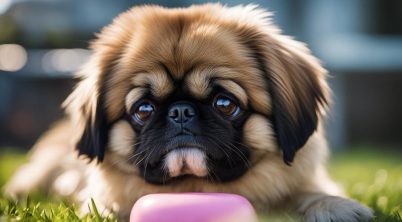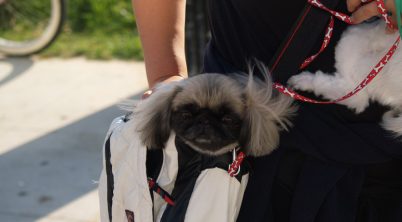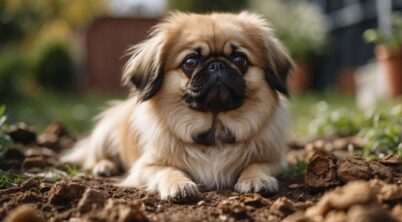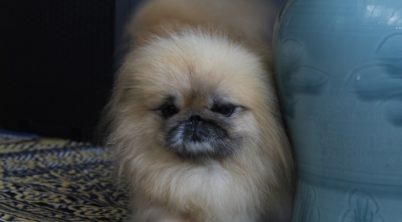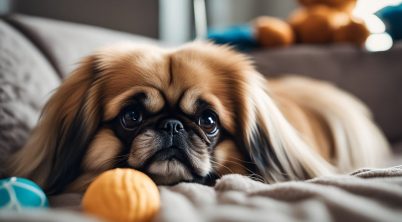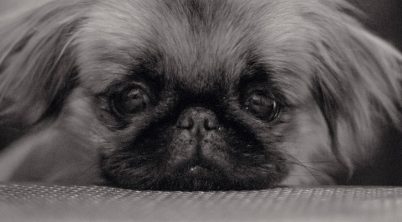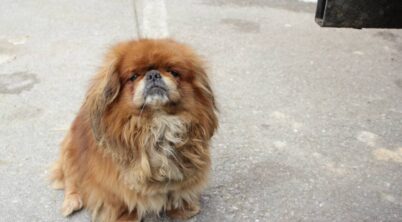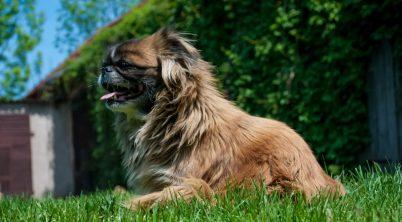Pekingese dogs are indeed known for shedding significantly. This breed possesses a luxurious double coat consisting of a thick undercoat and a long, straight topcoat. Their coat is not only a defining feature but also one of the main reasons for the amount of hair they leave around the home. The natural shedding process in Pekingese can vary from one individual to another, with some shedding moderately while others might shed heavily. Regular grooming is key to managing their shedding and ensuring their coat remains healthy.
Their shedding is influenced by several factors including seasonality, diet, and overall health. Pekingese typically experience a seasonal shed, commonly during spring and fall, in response to changing daylight and temperature which prompts their bodies to renew their coats. Additionally, elements like nutrition and underlying health issues can affect the frequency and volume of shedding. Thus, it’s important for owners to provide proper care through consistent grooming practices and attention to diet to minimize excessive shedding.
As a breed with a dense coat, it’s essential for potential and current Pekingese owners to be prepared for a routine that will manage their pet’s shedding. This involves regular brushing, often multiple times a week, to remove loose hairs and prevent mats and tangles. Such maintenance not only helps to control the amount of hair shed but also promotes a healthy coat and skin. Being well-prepared to handle the grooming needs of a Pekingese will ensure that the shedding is kept to a manageable level and the dog remains comfortable and healthy.
Table of Contents
Do Pekingese Shed a Lot?
Pekingese dogs, bringing along their beautiful and luxurious coats, are indeed recognized for their shedding. These small yet regal canines possess a double coat comprising of a thick undercoat and a long, straight outer coat. It’s the nature of their dense fur composition that causes them to shed a significant amount.
The degree of shedding for a Pekingese may vary from one individual dog to another due to differences in their hair type and overall health, but they are generally categorized as above-average shedders.
Here’s a succinct breakdown of Pekingese shedding:
- Frequency of Shedding: Steady throughout the year
- Increased Shedding Periods: During seasonal changes, particularly spring and fall
- Maintenance: Requires regular grooming sessions
| Grooming Need | Recommendation |
|---|---|
| Brushing Frequency | 2-3 times per week to remove loose hairs and prevent mats |
Owners should expect to perform regular grooming to manage their Pekingese’s shedding. This includes brushing their coat multiple times a week to not only manage the loose fur but also to prevent tangles and mats that can easily occur in their long fur.
It is noteworthy that factors such as nutrition, stress, and health can influence the amount of shedding. A well-balanced diet, a stress-free environment, and a clean bill of health can potentially reduce shedding, but they will not eliminate it completely due to the breed’s natural characteristics.
In summary, Pekingese dogs do shed substantially which calls for diligent grooming routines. Potential and current owners need to be prepared for a certain level of hair around their home and on their clothing. Proper care and regular grooming can help to mitigate the impact of their shedding.
Understanding Pekingese Shedding
Pekingese dogs are known for their long, beautiful coats that do require regular grooming due to their shedding. Their shedding patterns and the influence of their coat types are important considerations for potential owners.
Shedding Patterns
Pekingese shed throughout the year, with peaks during seasonal changes. They have a double coat, consisting of a thick, soft undercoat beneath a longer, straight outer coat. This type of coat is designed to provide insulation but results in a fair amount of shedding. It’s not uncommon for Pekingese to shed more profusely during spring and autumn as they prepare for the changing weather by either shedding their winter undercoat or thickening it up in anticipation of colder months.
Influence of Coat Type
The Pekingese’s coat comes in a variety of lengths and thicknesses, which can influence the extent of shedding. Dogs with a heavier coat tend to shed more, while those with a lighter undercoat may shed less. Regardless of the thickness or length, their hair is prone to matting and knots, making regular brushing a necessity. Brushing 2 to 3 times a week helps to remove dead hair and distribute oils from the skin throughout their coat, which can help to reduce the amount of shedding and keep the coat healthy.
Factors Affecting Shedding
The degree to which a Pekingese dog sheds can be influenced by several key factors that directly impact the condition of their coat. Understanding these can help mitigate shedding to some extent.
Diet and Nutrition
The quality of a Pekingese’s diet plays a critical role in the health of their fur. Proper nutrition can ensure a robust and less prone-to-shedding coat. Nutrients such as omega-3 fatty acids have been known to improve coat health, and diets lacking essential vitamins, minerals, and proteins can lead to increased shedding.
- Essential Nutrients:
- Proteins: Promote hair growth and repair.
- Fatty Acids: Omega-3s in particular support a shiny coat.
- Vitamins: Especially Vitamin E and B-complex for skin and fur health.
Health and Wellness
A Pekingese’s overall well-being significantly affects their shedding rates. Stress, health issues like hormonal imbalances (including thyroid issues), and parasites such as fleas or mites can result in excessive shedding.
- Health Conditions:
- Stress: Can increase shedding.
- Parasites: Lead to skin irritation and hair loss.
- Hormonal Imbalance: Affects the growth cycle of hair follicles.
Maintaining routine health checks and addressing any concerns promptly can help in managing the amount of shedding.
Grooming Essentials
Maintaining a Pekingese’s luxurious double coat demands regular grooming rituals focused on thorough brushing and proper bathing. These practices are imperative to manage shedding and keep the dog’s coat healthy and mat-free.
Brushing Techniques
Brushing a Pekingese should be a daily routine to effectively remove loose hair and prevent matting. One should use a slicker brush, which is ideal for detangling and smoothing out the dog’s flowing coat. When brushing, it is essential to be gentle and thorough, working through the coat layer by layer.
- Start brushing: from the head, progressing down towards the tail and underbelly.
- Be systematic: part the coat and brush it section by section to ensure no area is missed.
- Frequency: Daily brushing helps to minimize shedding and keeps the coat in optimal condition.
Bathing and Cleaning
While Pekingese do not require frequent baths, regular intervals of bathing help in controlling shedding and maintaining skin health. A gentle dog shampoo should be used to avoid stripping the coat of natural oils.
- Pre-bath brushing: helps to remove tangles and loose hair beforehand.
- Bath process: Use warm water and massage the shampoo into the coat, paying attention to avoid the sensitive eye area.
- Rinse thoroughly: Ensure all shampoo residue is washed out to prevent skin irritation.
- Post-bath brushing: Once the coat is dry, brush the dog to give the coat a smooth finish.
Regular grooming practices ensure the Pekingese’s coat remains beautiful and healthy while also providing an opportunity to check for any skin or health issues.
Shedding Management
Managing shedding effectively ensures that the Pekingese’s coat remains healthy and the shedding is kept to a reasonable minimum. Two key strategies are utilizing deshedding tools and engaging professional grooming services.
Deshedding Tools
Deshedding tools are crucial for Pekingese owners to reduce the amount of hair shed around the home. A must-have tool is the deshedding brush, designed to reach deep into the dog’s double coat to remove loose fur without damaging the skin. Brushing should take place several times a week, increasing to daily during periods of higher shedding, such as the seasonal coat blow. Regular use of these tools can substantially reduce shedding in Pekingese.
Professional Grooming
Consulting a professional groomer can significantly aid in managing a Pekingese’s shedding. Groomers possess the expertise to handle dense coats and can provide services like de-matting, trimming, and bathing, which contribute to the overall reduction of loose hair. Their skillful grooming prevents tangles that can exacerbate shedding and maintains the coat in optimal condition, promoting healthier skin and fur. It’s recommended for a Pekingese to visit a groomer every 4-6 weeks, ensuring consistent coat management and hygiene.
Health and Pekingese Coat Care
Maintaining the coat of a Pekingese is crucial, not only for aesthetic purposes but also to uphold the dog’s overall health. This section will discuss common health issues linked with their coat and preventative measures that can be taken.
Common Health Problems
Pekingese dogs are prone to several health problems that can directly affect their coat condition. Their luxurious double coat is a haven for fleas, ticks, and other parasites, which can cause extensive skin irritation and infection. Skin diseases, often manifested as hot spots or alopecia, can derive from unchecked parasite infestations. Additionally, hormonal imbalances and poor nutrition often lead to a lackluster coat and excessive shedding.
Preventative Measures
To ensure a healthy coat and mitigate Pekingese health concerns, owners should adopt a multifaceted care regiment that includes:
- Regular Grooming: At least once a week, a thorough brushing helps to remove loose fur and prevent matting.
- Veterinarian Visits: Regular check-ups can catch early signs of skin problems or parasites.
- Nutrition: A diet tailored to their needs, rich in proteins and omega fatty acids, promotes a healthy coat.
- Parasite Control: Routine applications of flea and tick preventatives prescribed by a veterinarian are essential.
By focusing on comprehensive preventative care, Pekingese owners can play a pivotal role in minimizing health risks and maintaining the overall well-being of their cherished companions.
Living With a Pekingese
Living with a Pekingese means accommodating their grooming needs and enjoying their affectionate company. Owners must manage allergens effectively and provide thoughtful care and socialization for their companion animals.
Managing Allergens
Pekingese dogs have a double coat that sheds moderately, contributing to allergens like dander and saliva which can affect individuals with allergies. To minimize allergens in the home, owners should:
- Implement a regular grooming routine, including brushing the coat 2-3 times per week to reduce loose fur.
- Use air purifiers to filter out pet dander.
- Ensure frequent laundering of pet bedding and any fabrics the dog comes into contact with.
- Consider establishing a pet-free zone, typically the bedroom, to limit allergen exposure during sleep.
Companionship and Care
Pekingese are affectionate dogs that thrive on companionship and require considerate care. They are well-suited as companion dogs and often form strong bonds with their owners. To ensure their well-being, owners should:
- Ensure daily socialization to keep their Pekingese well-adjusted and friendly.
- Schedule regular veterinary check-ups, addressing potential issues such as skin diseases or hormonal imbalances that can affect shedding.
When adopting from an animal shelter, potential owners should inquire about the Pekingese’s history of care and any socialization efforts to understand their needs fully. Proper care from the onset can help manage shedding and establish a pleasant living environment.

